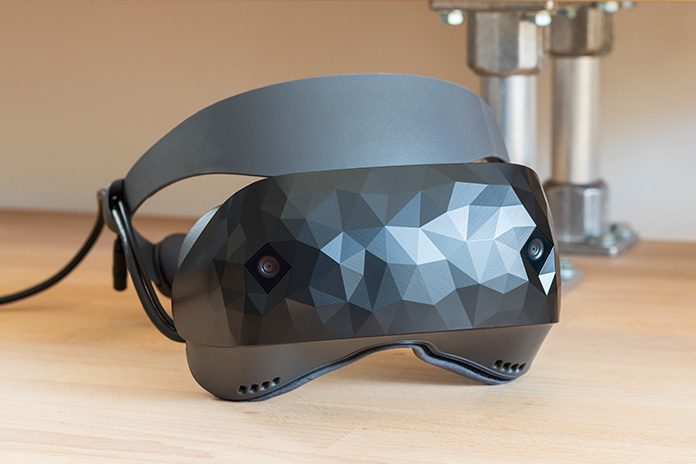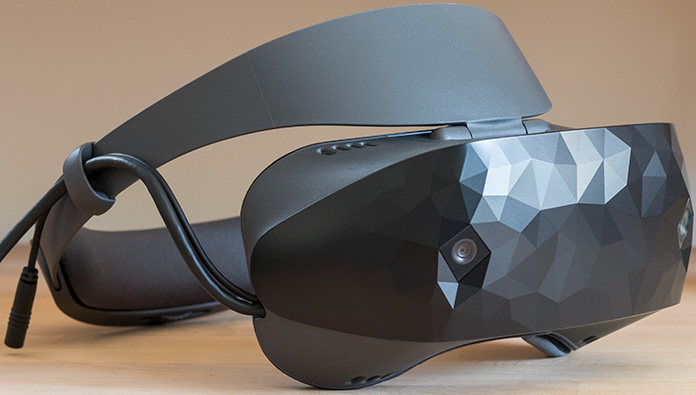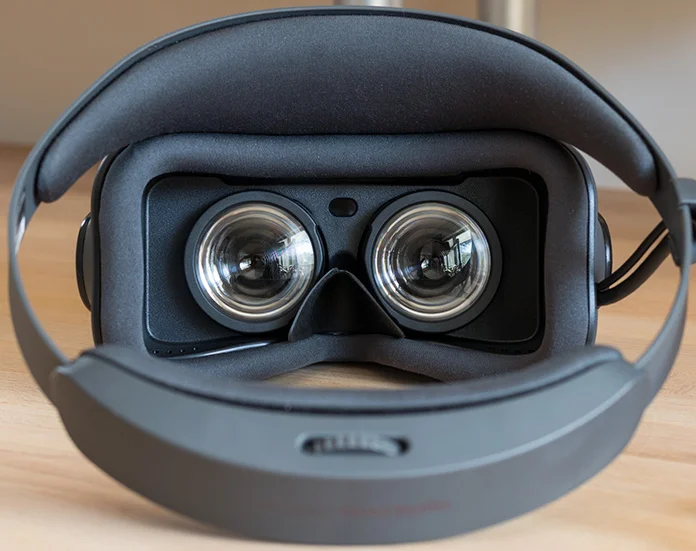
VR has quickly become one of the most exciting new technologies around, especially for the PC industry. Although we’re still a ways from the Holodeck, the experiences available today will recalibrate your expectations for immersion. Sure, you know you’re not really blasting swarms of enemy drones in a futuristic spaceport, taking in the view from the summit of Mount Everest, or rearranging furniture in the seaside abode of your dreams. But the combination of slick graphics, intuitive interaction, and fluid motion tracking blurs the line just enough to forget everything outside your new digital existence.
While initial virtual reality solutions for the PC have been transformative, their realities have also been complicated. The required external sensors complicate setup, and steep system requirements shut out machines that lack serious horsepower. Being strapped in for prolonged periods is also no picnic, often leading to fatigue and a flush VR face that hamper how long you can sustain your escape from the real world.
We addressed these flaws by designing the ASUS HC102 Windows Mixed Reality Headset to simplify VR for a wide audience. It turns tracking inside out to reduce setup time to minutes and loosens hardware restrictions to let even conventional laptops get in on the action. More importantly, the lightweight headset is tailored for comfort, allowing you to explore virtual realms for hours on end.

Built for binging on VR
As amazing as virtual reality is inside the goggles, your resulting expression of slack-jawed wonder inevitably looks a bit silly to everyone on the outside. We’d rather not dial down the awe that produces this less-than-attractive gape, so we made the headset distinctive enough to distract observers. The visor is covered by an abstract polygon landscape that fades away at the edges, echoing the divide between real and virtual worlds. Our designers created this pattern using digital architecture techniques and honed it with 3D-printed prototypes, resulting in a headset that looks as futuristic as the experience it provides.
VR headgear inevitably adds weight that can make longer sessions draining, even for seated experiences that don’t have you flailing around with your body. At 400 g, the HC102 headset is noticeably lighter than the competition, in some cases by a lot; the Oculus Rift tips the scales at 470 g, while the HTC Vive weighs 555 g, and the PlayStation VR balloons to 610 g.
The HC102’s minimal weight is well balanced between your forehead and the back of your skull, so the headset sits securely with only light tension on the band that wraps around your head. Twisting the dial at the back cinches the strap in notched increments that customize the fit in seconds. Adjustments can easily be made with one hand, which is especially helpful when you’ve got the requisite motion controllers hanging from each wrist.
Cushioning at the front and back of the band cradles your head comfortably even if you prefer to be strapped in tightly. Our designers experimented with different foam shapes and densities to find the best fit. They also focused on the fabric covering the pads, selecting a microfiber material that feels soft on your skin but incorporates grippy silicone rubber to prevent slippage. The material is cool to the touch, which helps reduce perspiration, and its combination of antibacterial and quick-drying properties help prevent the pads from getting funky. Some sweating is inevitable in more active games, like Sparc‘s stylized sportsball duels and Gorn‘s cartoonishly violent gladiator battles, but the cushioning is secured with hook-and-loop strips, so it conveniently peels off for cleaning.Unlike the Rift and Vive, which stay attached largely by squishing their goggles into your face, the HC102 suspends the display from the front of the headband. The visor hangs flush without pressing against the area around your eyes, which relieves much of the pressure and heat that makes longer adventures uncomfortable. It also sits on a hinge that allows the goggles to be flipped up in an instant, without removing the rest of the headset. This subtle feature is great for taking quick breaks mid-session, whether it’s to untangle the tether from your feet, type something at the keyboard, or simply catch your breath after an especially intense moment. And getting suited up is much simpler when you can see; you can dial-in the band, don headphones, and strap the controllers to your wrists before lowering the display to complete your plunge into VR.
Turn me inside out
After flipping down the goggles, you’re greeted by a digital world drawn at a much higher resolution than what’s available in typical VR headsets. The HC102 pumps out 1440×1440 per eye, or 2880×1440 combined, which is 60% more pixels than the Oculus Rift and HTC Vive, and double what you get from the PlayStation VR headset.
More megapixels make a big difference in VR, where the screen is right in front of your eyes, and the HC102 plainly illustrates why. Its LTPS LCD produces a sharp picture with less of the “screen-door effect” that makes lower-res VR headsets look pixelated. The subtler pixel boundaries impart a seamlessness that’s particularly apparent with solid textures like the stark backdrop for SUPERHOT‘s slow-motion gunplay, the seemingly endless sea surrounding you in theBlu, and the music-fueled orbs advancing upon you in Audiosurf. At the same time, the higher resolution makes details look sharper, which is especially noticeable with all forms of text, from in-game menus and HUDs to web pages in Microsoft’s virtual Edge browser.

Movement and animation are smooth inside the HC102 thanks to the display’s 90Hz refresh rate, which is the same as on other contemporary headsets. The backlight strobes with each refresh, turning on long enough to illuminate the new frame before going dark again to minimize ghosting and blurring. The combination of high refresh and low persistence is key to avoiding the motion sickness some people experience in VR.
Responsive motion tracking is also extremely important for preventing disorienting discomfort in virtual reality. A simulated world can look as lifelike as you want, but the illusion falls apart if you shift your head to look around at all the awesome, and the view fails to fluidly follow your gaze. Even a slight delay between real-world movements and their virtual manifestations can ruin the moment and remind you that you’re not really there, sometimes with nauseating results. To avoid this, VR solutions for the PC have traditionally tracked headset and controller movement using external sensors arranged around the boundaries of the play area. External sensors take longer to set up, which can be especially annoying when moving your rig around, and you have to find space for them, which can be difficult in smaller rooms and apartments. Fortunately, the HC102’s inside-out tracking achieves the responsiveness and precision vital for VR without relying on cumbersome external sensors. Instead, the headset integrates sensors that monitor the world around you, reducing the complexity of the system.
Project Cars is one of the most graphically impressive games around, both inside and out of VR, so it’s a good match for the headset’s high-resolution display. But to be honest, I’m even more impressed by what the upgraded screen does for cartoonish visuals that bear little resemblance to real life. Minecraft‘s blocky landscapes are about as far from the uncanny valley as you can get, yet they’re presented with a clarity that helps suspend disbelief. The same goes for Job Simulator‘s convenience store, which feels a little bit like being inside The Simpsons.
| HC102 Windows Mixed Reality Headset | |
|---|---|
| Display | 2.89" 1440x1440 per eye 2880x1440 combined resolution |
| Refresh rate | 90Hz |
| Field of view | 95° horizontal Fresnel-Aspherical |
| Sensors | Gyroscope, accelerometer, magnetometer, proximity |
| Camera | 2 x inside-out tracking |
| Audio | 3.5-mm headset jack |
| Connectivity | HDMI 2.0, USB 3.0 |
| Weight | 400 g |
| Controllers | 2 x wireless 6DoF |
| MSRP | $429 USD |
| Availability (USA) | ASUS Store B&H |
Be anywhere else
We all want to escape the reality around us. Even at the best of times, our day-to-day lives are considerably more ordinary than the exotic environments and compelling interaction we can simulate. VR has long promised a more satisfying way to sate our thirst for virtual experiences, and the ASUS HC102 Windows Mixed Reality Headset makes that exciting future accessible today.
The HC102 gets you into VR faster and helps you stay there longer. Its lower system requirements and simplified setup make virtual reality more approachable, and its light weight and cushy design enable extended trips in greater comfort. You don’t have to be a gamer, either. Between videos and other forms of entertainment, plus intriguing potential for productivity and even fitness, there’s something for virtually everyone. Get the ASUS HC102 Windows Mixed Reality Headset today for $429 USD from the retailers listed in the table above.
Comments
Post a Comment